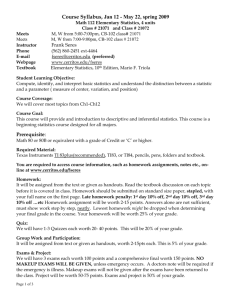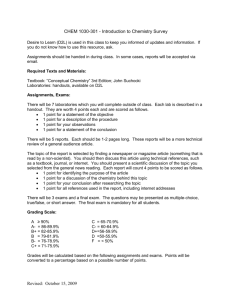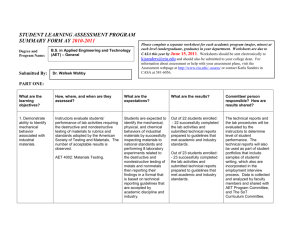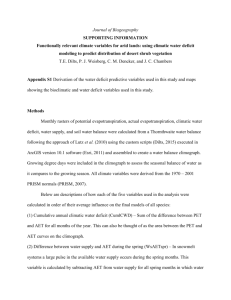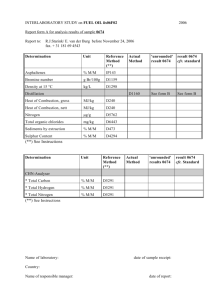STUDENT LEARNING ASSESSMENT PROGRAM
advertisement
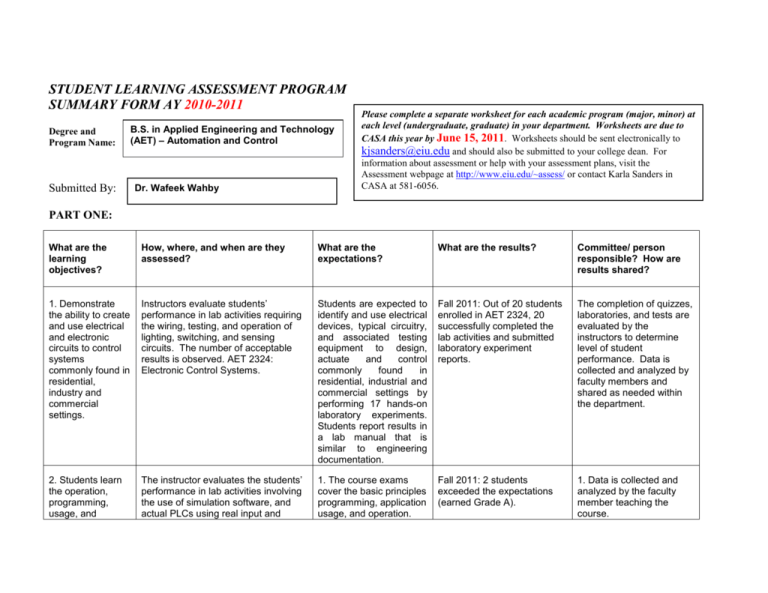
STUDENT LEARNING ASSESSMENT PROGRAM SUMMARY FORM AY 2010-2011 Degree and Program Name: Submitted By: B.S. in Applied Engineering and Technology (AET) – Automation and Control Dr. Wafeek Wahby Please complete a separate worksheet for each academic program (major, minor) at each level (undergraduate, graduate) in your department. Worksheets are due to CASA this year by June 15, 2011. Worksheets should be sent electronically to kjsanders@eiu.edu and should also be submitted to your college dean. For information about assessment or help with your assessment plans, visit the Assessment webpage at http://www.eiu.edu/~assess/ or contact Karla Sanders in CASA at 581-6056. PART ONE: What are the learning objectives? How, where, and when are they assessed? What are the expectations? What are the results? Committee/ person responsible? How are results shared? 1. Demonstrate the ability to create and use electrical and electronic circuits to control systems commonly found in residential, industry and commercial settings. Instructors evaluate students’ performance in lab activities requiring the wiring, testing, and operation of lighting, switching, and sensing circuits. The number of acceptable results is observed. AET 2324: Electronic Control Systems. Students are expected to identify and use electrical devices, typical circuitry, and associated testing equipment to design, actuate and control commonly found in residential, industrial and commercial settings by performing 17 hands-on laboratory experiments. Students report results in a lab manual that is similar to engineering documentation. Fall 2011: Out of 20 students enrolled in AET 2324, 20 successfully completed the lab activities and submitted laboratory experiment reports. The completion of quizzes, laboratories, and tests are evaluated by the instructors to determine level of student performance. Data is collected and analyzed by faculty members and shared as needed within the department. 2. Students learn the operation, programming, usage, and The instructor evaluates the students’ performance in lab activities involving the use of simulation software, and actual PLCs using real input and 1. The course exams cover the basic principles programming, application usage, and operation. Fall 2011: 2 students exceeded the expectations (earned Grade A). 1. Data is collected and analyzed by the faculty member teaching the course. application of programmable logic controllers (PLCs). The input and output devices commonly used in industrial settings are explored. output devices commonly used industrial settings. AET 3073: Programmable Logic Controllers. 2. Twelve labs and homework provide the students with an understanding of basic PLC principles as used in industry 2. Data is shared within the department. 3. Exams, quizzes, labs, and homework are classified by content area and analyzed in order to find the weakest areas that show poor performance. Subsequently, corrections are made to the course content to correct the weakness. 4. Instructor interviews students to determine areas of improvement in the course content. 3. Students learn the operation, programming, usage, and application of robots with the support equipment interfacing with the robot to create an automated system commonly used in industrial settings. The instructor evaluates the students’ performance in multiple lab activities involving the use of simulation software, actual robots, various support equipment such as PLCs and other devices commonly used industrial robotic work cell. AET 3103: Robots and Control Systems. 1. The course exams cover the basic principles of robotic programming, types of robots, path analysis, applications, and operation of robots. 2. Eleven hands-on labs provide the students with an understanding of basic robotic principles as used in industry. Fall 2011: Out of 5 students enrolled in AET 3103, 4 successfully completed the lab activities and passed exams. 1. Data is collected and analyzed by the faculty member teaching the course. 2. Data is shared within the department. 3. Exams and labs are classified by content area and analyzed in order to find the weakest areas that show poor performance. Corrections are then made to the course content to correct the weakness. 4. Instructor interviews students to determine areas of improvement in the course content. 4. Students learn the operation, programming, The instructor evaluates the students’ performance in multiple lab activities involving the use of the various types 1. The course exams cover the basic principles of the types of barcodes, Spring 2011: Out of 12students enrolled in AET 4833, 12 successfully 1. Data is collected and analyzed by the faculty member teaching the usage, and application of automatic identification devices such as barcoding and radio frequency identification (RFID) with the support hardware and software that interfaces with automated system such as robots. of barcoding systems in common use, the printing of barcode labels, the three frequency types of passive RFID tags and their associated reader/writers, middleware that interfaces with the RFID reader to the computer, and database software that stores the tag data. AET 4833: Automatic Identification and Data Capture. RFID tags, readers, writers, and printers. Included are the middleware needed for each type of automatic identification system. 2. Hands-on labs provide the students with an experience in using, operating, interfacing, and understanding of basic automatic identification and data capture principles as used in industry and commerce. completed the lab activities and passed exams. course. 2. Data is shared within the department. 3. Exams and labs are classified by content area and analyzed in order to find the weakest areas that show poor performance. Corrections are then made to the course content to correct the weakness. 4. Instructor uses the student evaluation section where students enter written comments about the course content, etc in addition to the item 3 analysis.



